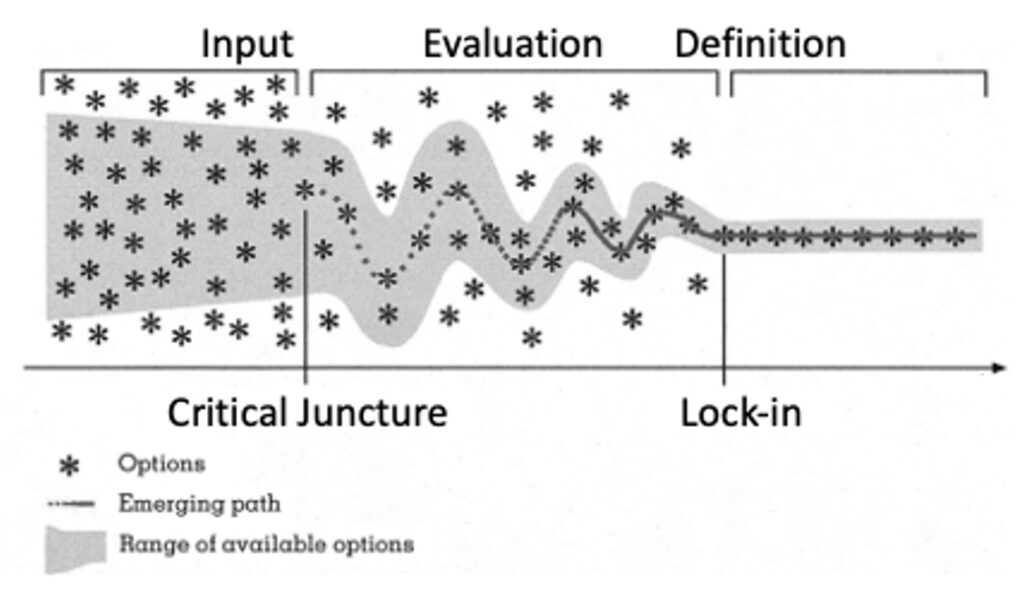

Always Start with a Strategic Premise
Issue 60: June 16, 2022
You’ve developed an aspirational strategic plan that is going to help you crush it compared to your competitors and allow the organization to expand its customer base and be more relevant to existing customers. The direction of the plan and its goals seem to address the declining performance of existing business lines and offerings by developing a new model.
You’ve worked on it, honed it, and vetted it with your executive team and board of directors. On the surface, everyone appears to be supportive. Your communications group has crafted organization-wide messaging to introduce the new strategic direction to customers and the public at large. On a whim, communications shared the message with a few selected customers to be sure the plan is clear, compelling, and actionable.
Then everything fell apart. The feedback received was undebatable. Customers asked so many questions that the communications team was confused, and they didn’t have any answers. When communications shared the feedback with the executive team and board, nearly all these key leaders also became confused. Executive management counted on staff across the organization with the knowledge and experience to raise the red flag if any issues existed. Why weren’t the customers getting it? It all seemed so clear.
To say they were blindsided was an understatement. Everyone involved, including those on the board, believed in their perceptions of what customers want and need. They were shocked when they heard customers didn’t see the value the organization was going to create via this new strategic direction. Where did this all go wrong? What feels “good” and “right” on the surface can be based on faulty premises, which is the case in this scenario.
Foresight is Hindsight
The strategic planning effort lacked the key exercise of creating a strategic premise: defining the context for the plan, vetting scenarios that are tested and validated with accurate data, determining the orientation towards the market, and understanding clearly how the market perceives its relationship with the organization and its expectations about what it wants from the organization. That’s a lot, but it’s an absolutely essential exercise.
Too often strategic plans are set in a vacuum, without context or data, overlooking the reason and the impetus of the “why.” The activity also misses necessary alignment with an organization’s capability and capacity correlated to the market’s true needs and wants. The resulting disconnect short changes any opportunity to coalesce an organization’s silos towards a vetted and validated shared purpose where everyone is working towards the same goals for the same reasons. The disconnect internally can be resolved when the team and individual contributions are clear, internalized, and understood. The disconnect externally resolves when the premises are more right than wrong. The key to this process is to clarify why the direction set by the plan is right and how the outcomes are achievable.
Strategic Planning with Blinders
This real-life experience is not uncommon. At 2040 we have found that there is often a disconnect across an organization when developing and introducing a strategic plan. A plan, stemming from fact not fiction, that depends on cross-functional execution, reflects an organization’s capacity and capabilities, divests, or retires poor-performing products or services, and most importantly conducts reprioritization requires buy-in from all key stakeholders. A disconnect can derail the plan from the get-go because it does not consider the operational challenges of who needs to do the work, how their roles and purpose will be redefined, and what the organization truly needs to achieve the set outcomes.
We say this is common because so often those involved in creating a strategy hold onto their own institutional knowledge and preconceptions of opportunity. Or those running the organization have no context of who the organization really is and whom they serve or seek to serve. They simply repeat what they believe to be a tried-and-true rote process.
Those involved rarely use critical thinking to see, define and understand all the environmental factors and variables that may impact the organization or create advantages. We live, work, and operate in a highly connected and interdependent world where single or multiple factors and variables can influence others and highjack our best-laid aspirational plans. Seeing with an objective eye, defining the vision in ways that are real and substantive, applying understanding and context, and using all this intelligence to develop the strategic direction is incredibly important if what results is to be relevant and productive.
Vision Matched with Precision
Most strategic planners have some sort of vision to support the activation of a transformative change baked into the plans. The vision is often exclusive since those involved in setting the plan have become attached to descriptions and words that mean something specific to them. However, the description may be understood differently by customers and/or the market. The exclusivity of the vision and limitations of the description may act as a natural inhibitor and cause prospective customers to believe they are neither included nor served by the organization.
Wordsmithing, not overused, hype terms, becomes a priority. The wording of important messaging seeks consensus. Without a common vernacular, some contentious voices around the table may sideline the plan based on misunderstandings.
When debates about wordsmithing take center stage, we have found that organizations have a difficult time translating their vision into the articulation of an actionable and measurable plan, stating how it brings value to the current and/or prospective marketplace.
Designing the Premise
A strategic premise is based on informed assumptions of how an organization serves or can serve its current or intended market. A premise stemming from a vision is informed by who an organization is and wants to be. The premise or premises are tested and validated to bring forth an understanding of capability and capacity, market demand, and opportunity. The premise can also serve as a competitive check and balance to assess how wide or deep an opportunity is and what competitors may already exist.
In our work facilitating organizations and their boards through the strategic planning process, we often find that in the planners’ desire to be global or enter a new space with offerings, they don’t first stop to ask the question of what the organizational capability and capacity is, who else is already in the market and whether the organization can be competitive given the required resources. Simplistically, if an organization has to start fresh and climb a mountain that others have already scaled, can the plan be achieved feasibly and economically? Is the mountain worth climbing?
Crafting a strategic premise can help bring more clarity and direction and identify what fits and what is no longer impactful or relevant. The strategic premise serves as the basic building block on which a full strategic plan can be built. The core elements of a strategic premise should leverage the organization’s strengths and potential opportunities. It should be concise and at the same time broad enough to be inclusive of the organization’s focus.
A good strategic premise starts with input from key constituents including board members, senior staff, and industry experts on the opportunities and strengths. This input is then evaluated based on core strengths, market opportunities, and interdependencies within the organization. This is a critical juncture in the process as it serves two purposes: obtaining input and buy-in and establishing relevant evaluation criteria.
Once the evaluation is completed, then the organization can lock in on the definition of its strategic premise which sets the course for the execution plan.
 Framework
Framework
A strategy is only as good as its execution. This sounds simple. However, research has shown that 90% of businesses fail to reach their strategic goals and set outcomes due to a gap between strategic planning, operational capacity, capability, resource availability, and execution.
The tested and validated strategic premise sets the framework for the development of the execution plan necessary to realize the strategic plan. The execution plan defines the when, where, and how. It also identifies the timeframe along with resource requirements and metrics. Any effective execution requires cross-functional support and accountability.
Silos
Achieving cross-functional support sounds straightforward, but we frequently see business models with inflexible organizational silos. These silos are typically driven by vertical organizational functions and financial reporting. What happens in silos? Each function is motivated to achieve its own goals without a holistic view of its contribution to the overall organizational goals. It’s hard to believe that organizations continue to silo their operations considering the level of research and case studies that demonstrate the value of systems thinking in problem-solving and operational execution.
A silo model leads to disagreement on priorities, creates high tension across teams, ingrains political maneuvers, and results in a lack of clarity of the bigger picture. It also ingrains a lack of cross-functional support as individuals and teams in silos are incentivized to achieve defined siloed results without context or connection of the contribution to the whole. Silos also create restraints on the organization’s ability to adapt to change as roadblock after roadblock is put up to ensure the available capability and capacity in a silo aligns with the incentives. Think about it: your department has its set of goals, individuals are incentivized to achieve their own goals, and none of this is correlated to the larger organizational goals. Any strategy is dependent on all the puzzle pieces fitting together seamlessly. It’s next to impossible for transformation, change or strategic direction to be achieved when the workforce is working against each other instead of pulling in the same direction led by a shared purpose.
Practical Steps to Creating an Effective Strategic Premise
Take a step back from the vision of transformation and parse the steps required to get buy-in from all key stakeholders. What are your assumptions – your premise – for the plan? A strategic premise needs to include all the following factors.
- Why are you creating a new strategic plan? Is your market orientation changing? Is it nice or necessary to transform?
- What is the outcome you envision? How will the new strategy affect stakeholders and the community you serve?
- What are the short- and long-term goals and outcomes?
- Research the premise and ways to achieve the goal; use objective data and don’t rely on gut instinct.
- How will the plan affect the workforce? What will they gain? What will they lose? How will their roles change?
- How will the plan activate cross-functionally? How can organization-wide cooperation be achieved?
The Strategic Premise Promise
At 2040, we help clients master how to approach strategic planning first with a premise. Deconstructing the vision and mission is the starting point to develop, test, and validate any strategic premise. No organization or individual can be all things to everyone. No organization or individual has limitless resources to even try. Starting with a set of strategic premises aligned with strategic and operational scenarios can lead to clarity and prioritization of resources, purpose, orientation, and realistic achievable outcomes. Our clients have learned the hard way that skipping the strategic premise step in any planning compromises the plan and typically ends up failing. We’re here to help you with our firsthand experience and the accrued wisdom of our team who has been in the trenches and understands how fragile success can be without smart planning. And that always starts with a strategic premise.
Get “The Truth about Transformation”
 The 2040 construct to change and transformation. What’s the biggest reason organizations fail? They don’t honor, respect, and acknowledge the human factor. We have compiled a playbook for organizations of all sizes to consider all the elements that comprise change and we have included some provocative case studies that illustrate how transformation can quickly derail.
The 2040 construct to change and transformation. What’s the biggest reason organizations fail? They don’t honor, respect, and acknowledge the human factor. We have compiled a playbook for organizations of all sizes to consider all the elements that comprise change and we have included some provocative case studies that illustrate how transformation can quickly derail.


